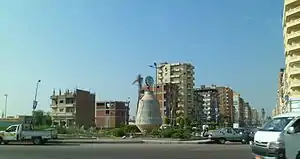Kafr El Dawwar
Kafr El Dawwar (Arabic: كفر الدوار Egyptian Arabic pronunciation: [kɑfɾ eddɑwˈwɑːɾ]) is a major industrial city and municipality on the Nile Delta in northern Egypt. It has a population of about 265,300 inhabitants,[2] and comprises a number of smaller towns and villages.
Kafr El Dawwar
كفر الدوار | |
|---|---|
City | |
 | |
 Location in Beheira Governorate | |
 Kafr El Dawwar Location in Egypt  Kafr El Dawwar Kafr El Dawwar (Egypt) | |
| Coordinates: 31°07′52″N 30°07′48″E | |
| Country | |
| Governorate | Beheira |
| Elevation | 6 m (20 ft) |
| Population (2012)[1] | |
| • Total | 88,191 |
| Time zone | UTC+2 (EET) |
| Area code(s) | (+20) 3 |
History
Kafr El Dawwar is a city near Alexandria where the famous Battle of Kafr El Dawwar took place between the Egyptian army headed by Ahmed Orabi and the British army during the 1882 Anglo-Egyptian War. For five weeks, Orabi was able to stop British forces from advancing toward Cairo. Changing their strategy, the British forces shifted to Suez canal to reach Cairo through Tel El Kebir.
In the vicinity of the city, there are a great number of ancient cemeteries (like Kom Ishu, Kom El Farag, Sidi Ghazi, Kom Defshu, Kom El Terfayeh, and Tell El Kanaies), where remains of pottery and some rocks from the Ptolemaic Era can be found.
Industry
The city is renowned for electricity generation as well as textile and fruit packing industries. Misr for Weaving and Spinning is the largest company in Kafr El Dawwar. Other industrial activities include paint, silk fibers and chemicals. Agriculture is a major activity for the countryside that surrounds the industrial area.
In September 1984 protests broke out in Kafr El Dawwar over efforts by then-dictator Hosni Mubarak to raise food prices during a period of wage decreases. Thousands of demonstrators threw rocks and occupied markets and roads. In response, security forces fired rubber bullets and tear gas, killing three persons at a milling plant and injuring dozens more.[3] Rioting spread to other centers including the Misr Spinning and Weaving Company in El-Mahalla.[3]
Geography
The Mahmudiyya canal (Arabic: ترعة المحمودية) goes through Kafr El Dawwar north to Alexandria. It branches west from the Nile and is the main source of drinking water and irrigation.
Climate
Classified by Köppen-Geiger climate classification system as having a hot desert climate (BWh).
Its highest record temperature was recorded on May 30, 1961 and was 45 °C (113 °F), while its lowest record temperature was recorded on January 31, 1994 and was 0 °C (32 °F). It also gets 38 rainy days annually on average.[4]
Rafah, Alexandria, Abu Qir, Rosetta, Baltim, Kafr El Dawwar and Mersa Matruh are the wettest places in Egypt.
| Climate data for Kafr El Dawwar | |||||||||||||
|---|---|---|---|---|---|---|---|---|---|---|---|---|---|
| Month | Jan | Feb | Mar | Apr | May | Jun | Jul | Aug | Sep | Oct | Nov | Dec | Year |
| Record high °C (°F) | 29 (84) |
33 (91) |
40 (104) |
41 (106) |
45 (113) |
44 (111) |
43 (109) |
39 (102) |
41 (106) |
38 (100) |
36 (97) |
29 (84) |
45 (113) |
| Average high °C (°F) | 17.7 (63.9) |
18.3 (64.9) |
20.8 (69.4) |
24.2 (75.6) |
27.5 (81.5) |
30.1 (86.2) |
30.4 (86.7) |
31.2 (88.2) |
29.8 (85.6) |
28.3 (82.9) |
24.4 (75.9) |
19.8 (67.6) |
25.2 (77.4) |
| Daily mean °C (°F) | 13.2 (55.8) |
13.7 (56.7) |
15.7 (60.3) |
18.6 (65.5) |
21.9 (71.4) |
25.1 (77.2) |
25.9 (78.6) |
26.5 (79.7) |
25.1 (77.2) |
23.1 (73.6) |
19.5 (67.1) |
15.1 (59.2) |
20.3 (68.5) |
| Average low °C (°F) | 8.7 (47.7) |
9.2 (48.6) |
10.7 (51.3) |
13 (55) |
16.4 (61.5) |
20.1 (68.2) |
21.5 (70.7) |
21.8 (71.2) |
20.5 (68.9) |
18 (64) |
14.7 (58.5) |
10.5 (50.9) |
15.4 (59.7) |
| Record low °C (°F) | 0 (32) |
0 (32) |
2 (36) |
4 (39) |
7 (45) |
12 (54) |
17 (63) |
18 (64) |
14 (57) |
11 (52) |
1 (34) |
1 (34) |
0 (32) |
| Average precipitation mm (inches) | 43 (1.7) |
29 (1.1) |
9 (0.4) |
3 (0.1) |
2 (0.1) |
0 (0) |
0 (0) |
0 (0) |
0 (0) |
6 (0.2) |
21 (0.8) |
41 (1.6) |
154 (6) |
| Source 1: Climate-Data.org[5] | |||||||||||||
| Source 2: Voodoo Skies for record temperatures[4] | |||||||||||||
Government
Kafr El Dawwar, like many other cities in Egypt, has a city council, which takes care of issues related to building permits and zoning.
Notable people
Kafr El Dawwar is the birthplace of former manager of Egypt's national football team, Hassan Shehata, where his statue is planned to be erected in the town center. It is also the birthplace of Tarek El Ashry, the former manager of Haras El Hodood football club, and actress Afaf Shoeib.
References
- "World Gazetteer". Archived from the original on 2013-04-12.
- Ottaway, David (2 October 1984). "Mubarak Orders Price Rollbacks To Quell Violence Near Alexandria". The Washington Post.
- "Kafr el-Dauwar, Egypt". Voodoo Skies. Retrieved 13 August 2013.
- "Climate: Kafr al Dawar - Climate graph, Temperature graph, Climate table". Climate-Data.org. Retrieved 13 August 2013.